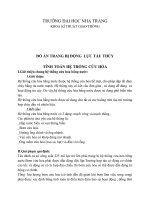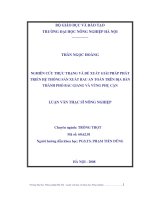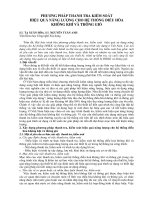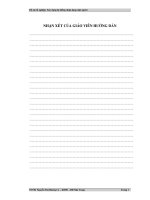HỆ THỐNG CỨU HỎA CO2 VÀ HALON TRÊN TÀU HÀNG (FIXED CO2 AND HALON ON BOARD)
Bạn đang xem bản rút gọn của tài liệu. Xem và tải ngay bản đầy đủ của tài liệu tại đây (181.22 KB, 5 trang )
Fixed CO2 & HALON Installation for cargo ships
The use of fixed installations must be carefully considered at an early stage especially in the
case of a cargo ships engine room fire. In particular Carbon Dioxide/Halons are to be used
before there is a build up of temperature causing severe convection.
In the case of a serious fire, to effectively use CO2/Halons, the time factor is probably in the
order of 10-12 minutes from the time that the fire situation is deemed to be beyond the
capability of first aid fire fighting equipment. Proper closing down of the space is essential
before the system is operated, and therefore the Chief Engineer Officer must make the necessary
preparations during the first aid fire fighting stage in accordance with the vessel’s Ventilation
Shut-down Plan.
In the majority of the ships the fixed fire extinguishing system to the Engine Room is
CO2/Halons. This is a "once off" shot and to have maximum effect all ventilation fans must be
stopped and the fire flaps closed. Several minutes may be required before all necessary
preparations have been completed and the CO2/Halons can be released.
Fig:CO2 total flooding system
As total loss of power may result from flooding the Engine Room with CO2/Halons the Chief
Engineer Officer must consult with the Master before releasing the CO2/Halons.
Once this course of action is decided upon the Senior Officer in charge of the Emergency Party
must act to release the CO2/Halons.
Prior to the release of any fixed gas based extinguishing medium in an enclosed space, and to
ensure that no personnel are present in that space positive verification is to be made by
mustering all the vessels crew.
After flooding with the extinguishing gas, a careful watch is to be made on the space
temperature. On no account is the space to be ventilated or opened up until the temperature has
fallen to a safe level. Failure to do this will result in the fire restarting with no further means to
control or extinguish it. Regardless of system fitted onboard, a description of the system is to be
included within the shipspecific Fire Training Manual.
Fig:CO2 total flooding system for engine room
Precautions Using Fixed C02 Systems
Once the system has been fully released and the fire extinguished, no personnel are to enter the
space until the main supply valve has been shut. The space must of course be well ventilated
prior to entry in order to remove all traces of CO2 and ensure sufficient air has been introduced
to make the space safe. It can take a considerable amount of time for the fire to be completely
extinguished and for the space to cool down. (in excess of 24 hours). Procedures for entry into
enclosed spaces are to be followed in such cases.
Halons 1301
Unlike CO2, Halons 1301 does not smother a fire. Instead it interferes with the combustion
cycle that occurs in a fire, arresting the heat producing reactions.
Whilst Halons is not toxic at normal temperatures at temperatures above 800C toxic vapours
may be given off. Therefore personnel must immediately evacuate a space where Halons has
been released into.
There are some environmental concerns over the use of Halons and as a result this type of firefighting medium is being phased out.
Maintenance of Carbon Dioxide and Halons Systems
The onboard planned maintenance system should include all maintenance requirements of the
fixed fire fighting system as outlined by the system manufacturers and the flag administration
including:
1.
2.
3.
4.
Maintenance and inspection procedures and instructions;
Required schedules for periodic maintenance and inspections;
Listing of recommended spare parts; and
Records of inspections and maintenance, including corrective actions taken to maintain
the system in operable condition.
The PMP should clearly indicate which parts of the recommended inspections and maintenance
schedule should be completed by competent trained personnel. Whenever fixed fireextinguishing systems are subjected to inspection or maintenance, care must be taken that the
system is not accidentally triggered off. Prior to performing any work, a risk assessment should
be developed .
Extreme care is also to be taken when inspecting the room where the extinguishing medium is
stored. Ventilation must be continuously running to eliminate any chances of asphyxiation which
may result from CO2 leaks.
In addition to the recommendations of the manufacturers, and in accordance with IMO
MSC.1/Circ.1318, the following items should be included within the PMS.
Monthly Inspections: CO2 / Halons alarms are to be tested monthly. Note, where CO2 / Halons
alarms automatically shut down ventilation and machinery on opening of control boxes,
appropriate precautions are to be taken to avoid shut down of machinery. Such tests shall be
made only with the Chief Engineer’s approval after consultation with the Master.
At least every 30 days a general visual inspection should be made of the overall system condition
for obvious signs of damage, and should include verification that:
all stop valves are in the closed position;
all release controls are in the proper position and readily accessible for immediate use;
all discharge piping and pneumatic tubing is intact and has not been damaged;
all high pressure cylinders are in place and properly secured; and
the alarm devices are in place and do not appear damaged.
In addition, on low pressure systems, the inspections should verify that:
the pressure gauge is reading in the normal range;
the liquid level indicator is reading within the proper level;
the manually operated storage tank main service valve is secure din the open position;
and
the vapour supply line valve is secured in the open position.
Annual Inspections: The boundaries of the protected space should be visually inspected to
confirm that no modifications have been made to the enclosure that have created uncloseable
openings that would render the system ineffective.
All storage containers should be visually inspected for any signs of damage, rust or loose
mounting hardware. Cylinders that are leaking, corroded, dented or bulging should be
hydrostatically retested or replaced.
System piping should be visually inspected to check for damage, loose supports and corrosion.
Nozzles should be inspected to ensure they have not been obstructed by the storage of spare parts
or a new installation of structure or machinery.
The manifold should be inspected to verify that all flexible discharge hoses and fittings are
properly tightened.
All entrance doors to the protected space should close properly and should have warning signs,
which indicate that the space is protected by a fixed carbon dioxide system and that personnel
should evacuate immediately if the alarms sound. All remote releasing controls should be
checked for clear operating instructions and indication as to the space served.
The bottle levels are also to be tested on an annual basis by ship’s staff using the testing
equipment supplied.
Inspections at each intermediate, periodical or renewal survey: All high pressure cylinders
and pilot cylinders should be weighed or have their contents verified by other reliable means to
confirm that the available charge in each is above 905 of the nominal charge. Cylinders
containing less than 90% of the nominal charge should be refilled. The liquid level of low
pressure storage tanks should be checked to verify that the required amount of carbon dioxide to
protect the largest hazard is available.
The hydrostatic test date of all storage containers should be checked. High pressure cylinders
should be subjected to periodical tests at intervals not exceeding 10 years. At the 10-year
inspection, at least 10% of the total number provided should be subjected to an internal
inspection and hydrostatic test. If one or more cylinders fail, a total of 50% of the onboard
cylinders should be tested. If further cylinders fail, all cylinders should be tested. Flexible hoses
should be replaced at the intervals recommended by the manufacturer and not exceeding every
10 years.
The discharge piping and nozzles should be tested to verify that they are no blocked. The test
should be performed by isolating the discharge piping from the system and flowing dry air or
nitrogen from test cylinders or suitable means through the piping.
Halons initiators must be replaced by a service engineer every three years. Inspections at Each
Renewal Survey by a Competent Authority
Where possible, all activating heads should be removed from the cylinder valves and tested for
correct functioning by applying full working pressure through the pilot lines. In cases where this
is not possible, pilot lines should be disconnected from the cylinder valves and blanked off or
connected together and tested with full working pressure from the release station and checked for
leakage. In both cases, this should be carried out from one or more release stations when
installed. If manual pull cables operate the remote release controls, they should be checked to
verify the cables and corner pulleys are in good condition and freely move and do not require an
excessive amount of travel to activate the system.
All cable components should be cleaned and adjusted as necessary and the cable connectors
should be properly tightened. If the remote release controls are operated by pneumatic pressure,
the tubing should be checked for leakage and the proper charge of the remote releasing station
pilot gas cylinders should be verified. All controls and warning devices should function normally
and the time ideally, if fitted, should prevent the discharge of gas for the required time period.
After completion of the work, the system should be returned to service. All releasing controls
should be verified in the proper position and connected to the correct control valves. All pressure
switch interlocks should be rest and returned to service. All stop valves should be in the closed
position. Masters are to refer to the regulations laid down by the Flag Administration / Class for
the requirements to hydraulically pressure test gas cylinders of fixed systems.
Fixed Dry Powder System
Fixed Dry Powder systems are to be checked monthly to ensure that valves are set correctly,
guns operate freely and nitrogen bottles are at the correct pressure. Every four months all pipe
work is to be blown through with compressed air.









